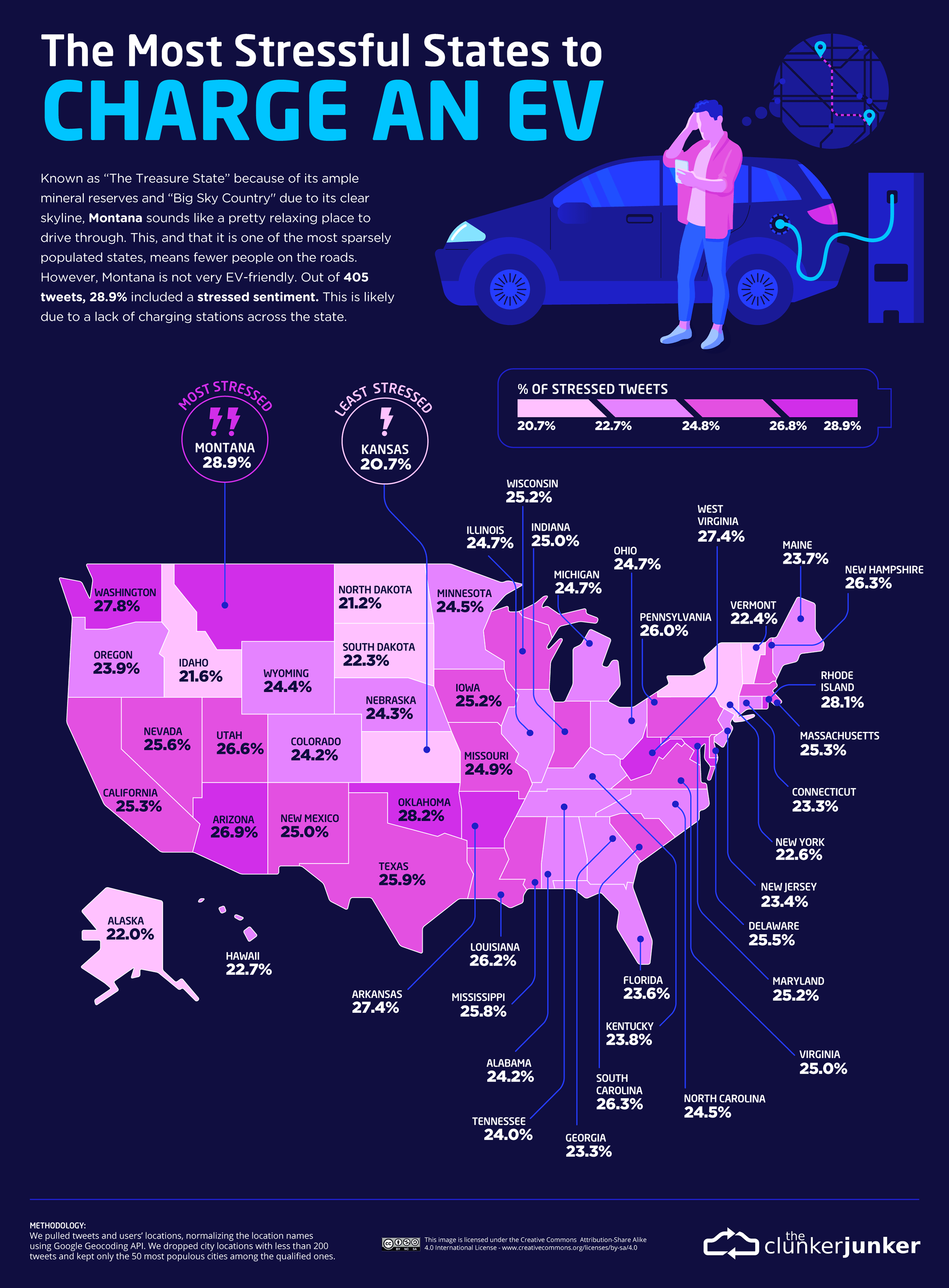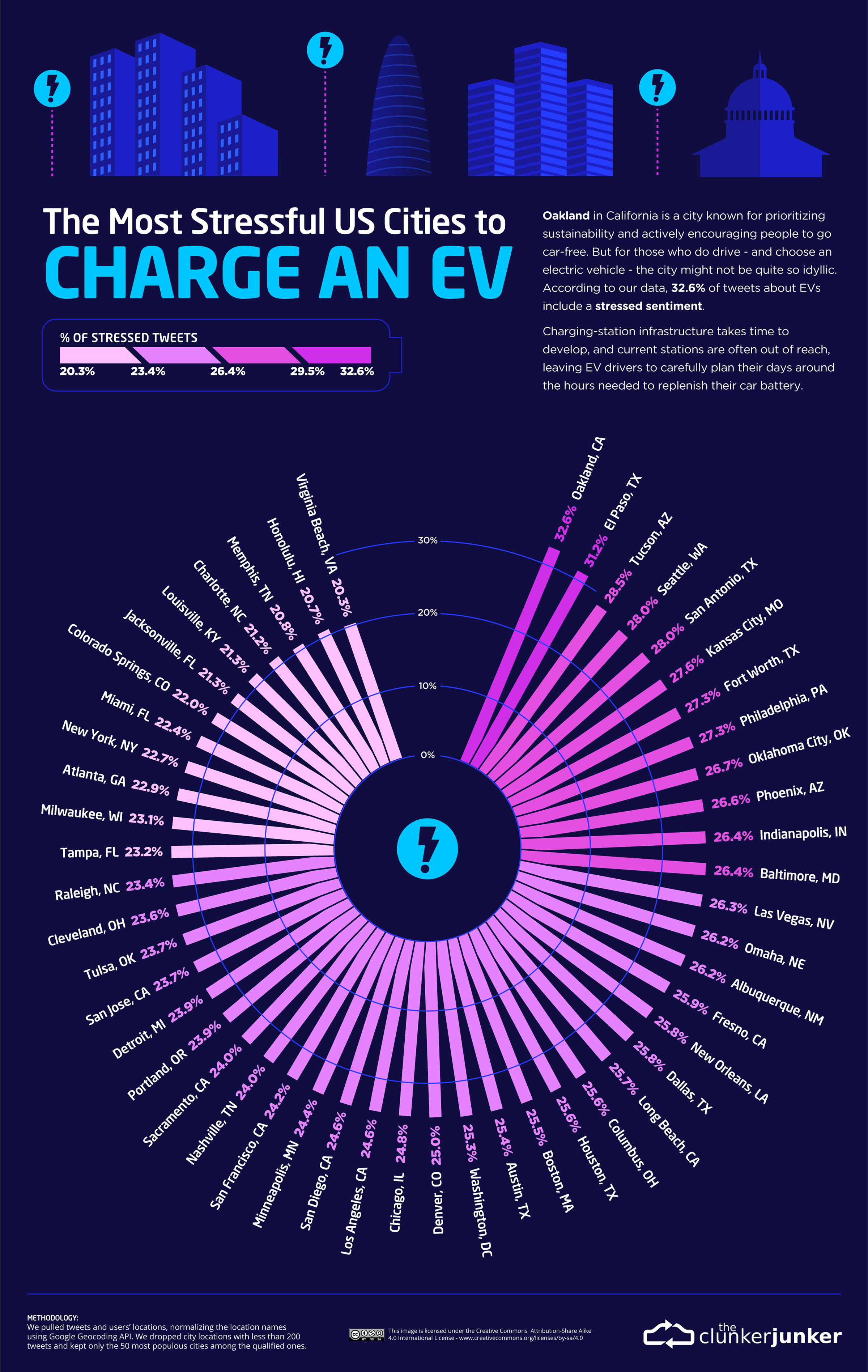The California Air Resources Board — which is charged with protecting the public from the harmful effects of air pollution and developing programs and actions to fight climate change — approved a stringent rule which requires that 100 percent of the sales of new cars, sport utility vehicles, and small pickup trucks in the state of California to be zero-emission vehicles by the year 2035, with interim targets that are designed to facilitate the phasing out of cars which require gasoline and diesel fuel. Perhaps by then, owning an electric vehicle may be easier than owning one with a combustion engine powered by gasoline or diesel fuel…
Where Charging Electric Vehicles Currently Causes the Most Stress In the United States
…but in what cities and states in the United States does charging electric vehicles currently — yes, that pun had to be used — cause the most stress?
To find out the answer to that question, messages from Twitter were extracted using the following set of queries: ‘plugshare,’ ‘chargeway,’ ‘Tesla Supercharger,’ ‘EV charger,’ ‘EV charging,’ ‘Tesla charger,’ ‘Tesla charging,’ ‘electric charging station,’ and ‘supercharger.’
Then, the locations of the users were collected; and the location names were normalized using Google Geocoding application programming interface.
At the city level, locations with fewer than 200 messages on Twitter were excluded and only the 50 most populous cities among the qualified ones were kept.
The data was collected in June 2022.
This article from The Clunker Junker gives more details about where charging electric vehicles in the United States currently causes the most stress; and I have been given express written permission to use the graphs and the verbatim text from the aforementioned article in this article. While The Clunker Junker has endeavored to ensure the information provided is accurate and current, it cannot guarantee it, as this information is general in nature only and does not constitute personal advice. Neither The Clunker Junker nor The Gate accept any liability — and assume no responsibility — for any and all information which is presented in this article.
With that disclaimer out of the way, here is the article.
Cities and States in the United States Where Charging Electric Vehicles Causes the Most Stress
Human ingenuity knows no bounds: as fast as we can design fabulous new solutions like the electric car, we can invent fabulous new neuroses – like “range anxiety.”
Range anxiety is the worry that your electric vehicle (EV) will run out of energy before you can reach a charging point (EVSE). It’s cell phone battery anxiety (technically known as nomophobia) with the added fear of getting stuck in the desert.
Power utilities around the U.S. are working to improve EVSE infrastructure (with the caveat that it’ll add to the rising energy bills of everybody – not just vehicle owners). But there’s another problem. Even if there’s an EVSE on your route, the time it takes to recharge remains inconvenient. It can be very tempting to risk running on empty to reach your destination on time. The U.S. boasts just 22,000 fast EVSEs (and 92,000 slow ones) compared to 150,000 roll-in, roll-out gas stations. The anxiety is real.
It helps to know in advance the likelihood of running into trouble. So, The Clunker Junker has identified the U.S. cities and states where EV range anxiety is most common.
What We did
he Clunker Junker gathered geotagged tweets featuring words and phrases related to charging an EV in every U.S. state and the 50 most populous cities. Then, we used an academic stress detection tool called TensiStrength to identify which ones showed signs of range anxiety.
Key Findings
- Montana is the state where EV charging causes the most stress, with 28.9% of related tweets showing signs of anxiety.
- Kansas has a stress rating of just 20.7%, making it the state with the least range anxiety.
- Oakland, CA, is the U.S. capital of range anxiety, with a 32.6% stress rating.
- Virginia Beach, VA, has the least range anxiety, with a stress rating of 20.3%.
One EV Charging Station Every 1100 sq. Miles Makes Montana Anxious
EV charging stress rates in the U.S. range from around 20-30% on both a city and state level. The state with the most range anxiety is Montana. At the start of 2022, the state had fewer than 3,000 fully electric or hybrid vehicles. Montana maintains one of the lowest EV uptake rates in the U.S. – perhaps because there are only 131 existing stations to serve America’s fourth-largest state by area.

However, EV registrations in Montana have doubled since 2019, and the state expects the number to rise to 130,000 by 2030. Some $43m of last year’s $1 Trillion Infrastructure Bill has been earmarked to counter range anxiety on the roads of Montana. This will help to level things out to Kansas’s anxiety levels – which are the lowest in any state, thanks to a total of nearly 460 EVSEs alongside the state’s 1,065 gas stations.
Oakland Apartment Owners Have Nowhere to Charge
Oakland, CA, is the most stressed big city in the U.S. when it comes to charging an EV. But with around 290 public charging spots available, anxiety may be confined to apartment-dwellers frustrated by the difficulties of charging overnight at home. “Level 2 charging should be required in all apartments,” tweets Brinda Thomas, a local owner with a PhD in Engineering and Public Policy. “I find it harder to charge an EV in Oakland than Fremont, bc of a lack of in-bldg charging. Most of the public charging options are in garages w 4-hr limits & require additional parking fees.”

The city with the least range anxiety is Virginia Beach, VA. The city has 63 charging stations right now. Still, itwill benefit from some of the $106.4 million allocated to the state to develop charging stations along designated Alternative Fuel Corridors, including on Interstate 64 between Virginia Beach and the border with West Virginia.
Life’s A Gas
The EV charging network has a long way to go before buying electric cars will feel ‘normal’ in the U.S. Today, neither the drivers nor EVSE providers feel comfortable with the situation. Motorists risk range anxiety or the worry of recharging in obscure parking lots, potentially after dark. Gas station and store owners, who are encouraged to install EVSEs, do not necessarily make a profit from their sales and are looking for reassurance that their efforts will be worthwhile. In our full data below, you will find exactly where the EV anxiety hits the hardest.
What are you going to do when your range fears are realized? When a cell phone runs short of battery, at least you can chat with other dwindling souls on the low-battery social network, Die With Me. Drivers who run out of juice can only hope there are fellow drivers to share a forlorn glance and perhaps signal for help. Battery swaps remain expensive and wasteful, while charge-sharing between cars requires network growth and availability. In the long term, help is on its way via the Infrastructure Bill. In the meantime, it’s best to keep enough battery on your cell phone, so you can at least tweet your range anxiety to the world.
Final Boarding Call
Although the range of miles of electric vehicles between refueling has been increasingly improving — to the point where it is approaching that of vehicles powered by gasoline — that range is still not there yet, which contributes to the aforementioned so-called range fears…
…and although more charging stations for electric vehicles exist, they are currently still not as ubiquitous as gasoline stations.
I really like the idea of electric vehicles — recharging the battery while sleeping overnight for supposedly a fraction of the cost of a full tank of gasoline is appealing to me; and not polluting the air when they are in use…
…but I always say that for every problem which is supposedly solved, at least one new problem emerges.
The main goal of the order is to reduce the emissions of personal motor vehicles — greenhouse gas emissions are forecast to be reduced by 35 percent and nitrogen oxide emissions by 80 percent as a result — which many scientists claim contributes to the global change in climate. That goal will technically be achieved with electric cars and other zero emissions vehicles…
…but will the carbon footprint of the manufacture of zero-emission vehicles also be reduced? After all, what type of energy is going to power the factories in the future? How will used batteries which have reached the end of their life span be disposed or recycled? What about other ancillary effects that may be involved in the manufacture of zero-emission vehicles?
Also, how much more money will zero-emission vehicles cost to purchase and operate than their combustion engine contemporaries? Will people be able to afford vehicles with the new technology — especially when a battery must be replaced?
Thirteen years is not a very long time to resolve the significant issues as a result of the switch to personal vehicles with zero emissions — and that can potentially cause substantially more stress than what was described in this article…
Photograph ©2022 by Brian Cohen.

